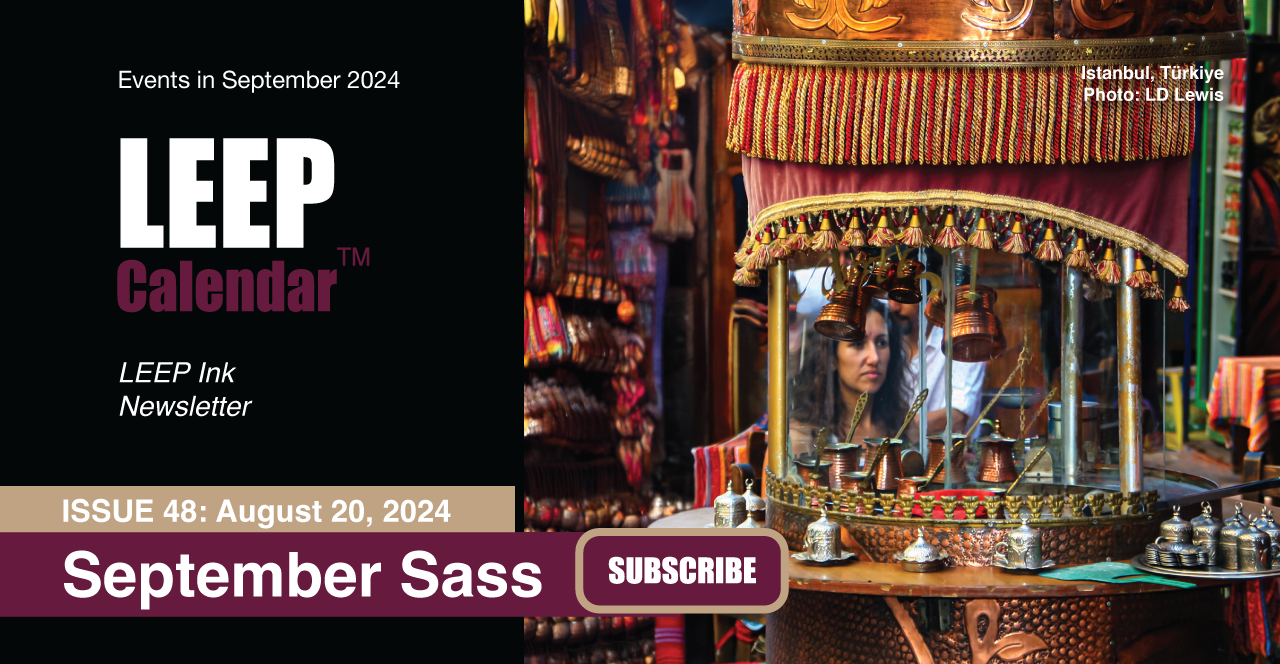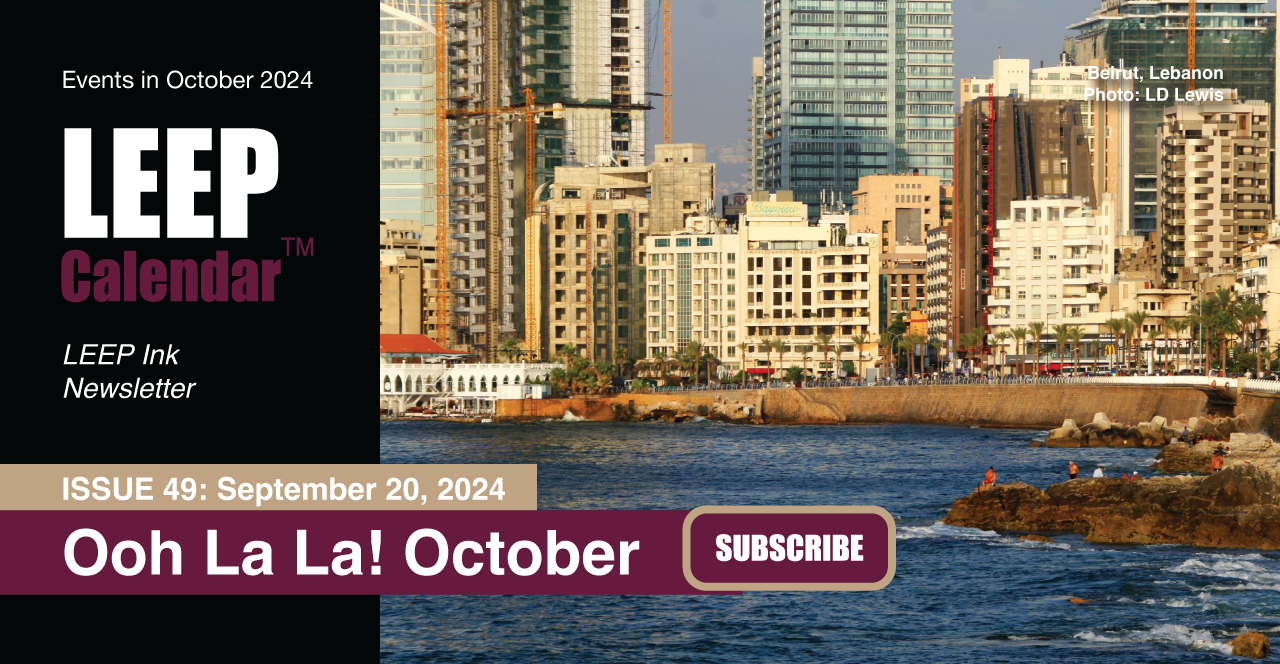 AD
AD
Country
- Africa
- Alcohol, Tobacco & Drugs
- Animals, Fish, Insects & Birds
- Anniversaries
- Australia
- Books
- Brazil & S.America
- Buddhism
Category
- Afghanistan, AF
- Aland Island, AX
- Albania, AL
- Algeria, DZ
- American, Samoa, AS
- Andarra, AD
- Angola, AO
- Anguilla, Al
Event Type
- Daily
- Weekly
- Annual
- Recurring
Duration
- All
- 1 Day
- 2 Day
- 3 Day
- 4 Day
- 5 Day
- 6 Day
Event Type
- Daily
- weekly
- Annual
- Recurring
Event Type
- Daily
- weekly
- Annual
- Recurring
Today is: October 06
American Music Awards
Armed Forces Day (EG)(1973)
Badger Day, Ntl. (UK)
Bed & Breakfast, Country Inn Day (US/CA)
Cerebral Palsy Day, World
Coaches Day, Ntl
Communion Sunday, World (C)
Daylight Savings (AU), Begins
Daylight Savings (PY), Begins
Erntedankfest (DE)
G.O.E. Day, Ntl.
Geodiversity Day, International
German-American Day (1683)
Grand Final NRL Telstra Premiership (AU)
Inn Mascot Day, Bed and Breakfast
Ivy Day (IE)(1891)
Mad Hatter Day
Mental Health Awareness Week, Ntl
Noodle Day (2009)
Physicians Assistant Day (1967)
Plus Size Appreciation Day
Quaker Day, World
Tzom Gedaliah (J)
Albuquerque Balloon Fiesta, Intl. (US-NM)
Amputee Awareness Week (AU)
Animal Welfare Week
Back Care Awareness Week (UK)
Borderline Personality Disorder Week (AU)
Carry a Tune Week, Ntl (1746)
Curry Week, Ntl. (UK)
Customer Service Week, Ntl. (US/UK)
Dance Week, Ntl.
Digital Inclusion Week
Disability History & Awareness Weeks (US/CA)
Drive Safely Work Week
Egg Week, Ntl. (UK)
Elderly Filipino Week (PH)
Emergency Nurses Week
Fat Bear Week
Fire Prevention Week, Ntl. (1871)
Fish Supper, RNLI (UK)
Fish Supper, RNLI (UK)
Golden Week (CN)
Healthcare Foodservice Week, Ntl.
Healthcare Supply Chain Week, Ntl.
Heimlich Heroes Week, Ntl.
Manufacturing Week, Ntl.
Marine Week, Ntl. (ZA)
Mental Illness Awareness Week
Metric Week, Ntl.
Mystery Series Week
Navratri (H)
Nobel Prize Announcements
Pchum Ben Festival (KH)
Pet Obesity Week, World
Physicians Assistant Week (1967)
Public Relations Week (Getting the World to Beat a Path to Your Door)
Red Squirrel Week (UK)
Semana Cervantina (ES)(1547)
Space Week, World (1957)
Vegetarian Week, Ntl. (UK)
Walk Your Dog Week, Ntl.
Work Life Week, Ntl.(UK)
Work from Home Week, Ntl
ADHD Awareness Month
Adhik Ashvina (H)
Adopt-a-Dog Month, (AHA)
Adopt-a-Shelter Dog Month
Advertising, Co-op Advertising Awareness Month
Animal Safety & Protection Month, Ntl.
Antidepressant Death Awareness Month
Anxiety and Depression Awareness Month (AU)
Apple Month, Ntl.
Applejack Month
AquaTober
Architecture Month, Archtober
Arts & Humanities Month, Ntl.
Asu (S)
Autism Awareness Month (CA)
Bake & Decorate Month, Ntl.
Bat Appreciation Month
Battery Safety Month (Auto)
Bi-national Health Week (US/CA/MX-varies locally)
Big Draw, The
Big Draw, The
Bilingual Child Month, Celebrating the
Black History Month (UK)
Black Speculative Fiction Month
Blind Month, National Meet the
Blindness Awareness Month
Book Month, Ntl.
Breast Cancer Awareness Month, Ntl.
Bullying Month, Stop, Ntl.
Bullying Prevention Month, Ntl.
Caffeine Addiction Recovery Month
Car Care Month, Ntl. Fall
Caramel Month, Ntl.
Celiac Awareness Month (US)
Cheese Month, American
Chili Month, Ntl.
Chiropractic Health Month, Ntl.
Church Library Month
Church Safety and Security Month, Ntl.
City, Urban October
Class Reunion Month
Clergy Appreciation Month
Co-op Awareness Month
Collegiate Alcohol Awareness Month, Ntl.
Company Culture Month, Global
Company Culture Month, Global
Computer Learning Month
Contact Lens Safety Month
Cookie Month
Corn Month
Country Ham Month
Country Music Month
Crime Prevention Month, Ntl.
Cybersecurity Month, Ntl.
Danger Run (US-KY, IN, IL)
Dental Hygiene Month, Ntl.
Depression Education & Awareness Month
Dessert Month, Ntl.
Disability Employment Awareness Month
Diversity Awareness Month, Global
Domestic Violence Awareness Month
Down Syndrome Month, Ntl.
Dyslexia Awareness Month
Eat Better—Eat Together Month
Eczema Awareness Month
Emotional Intelligence Awareness Month
Energy Action Month, Ntl.
Eye Injury Prevention Month
Festival of Penha (BR-RJ)
Filipino American History Month (1587)
Financial Planning Month
Freethought, Month of, Ntl.
Gain the Inside Advantage Month, Ntl.
Gay & Lesbian History Month (1979)
German-American Heritage Month (1683)
Girls Night In (AU)
Go Sober Month (UK)
Golf Month, Australia
Great Cycle Challenge (AU)
Halloween Safety Month
Head Start Awareness Month
Health Literacy Month
Healthy Lung Month
Healthy Workplace Month (CA)
Hearing, Audiology Awareness Month, Ntl.
Hemophilia, Bleeding Disorders Month, Ntl. (AU)
Hispanic Heritage Month
Home Eye Safety Month
Indoor Air Quality (IAQ) Month, Ntl.
Islamic History Month (CA)
Italian-American Heritage Month (1492)
Kitchen & Bath Month, Ntl.
Learning Disabilities Month, Ntl. (CA/US)
Liver Awareness Month, Ntl.
Lupus Awareness Month (UK)
Medical Librarians Month, Ntl.
Medicine Abuse Awareness, Ntl.
Menopause Month, World
Muslim American Heritage Month (US)
Organize Your Medical Information Month
Orthodontic Health Month, Ntl.
Pedestrian Safety Month
Pescatarian Month, Ntl.
Pet Wellness Awareness Month, Ntl.
Pharmacist Month, American
Photographer Appreciation Month
Physical Therapy Month, Ntl.
Pickled Peppers Month
Pink Ribbon Breakfast (AU)
Pit Bull Awareness Month, Ntl.
Pituitary Awareness Month (UK)
Pizza Month, Ntl. (1984)
Polio Awareness Month, (CA/AU)
Polish-American Heritage Month
Popcorn Poppin' Month, Ntl.
Positive Attitude Month
Principal's Month, Ntl.
Rabi al-Thani (M)
Reading Group Month, Ntl. (1917)
Rett Syndrome Awareness Month
Roller Skating Month, Ntl.
STEM Mentoring Month
Sarcastic Awareness Month
Sausage Month, Ntl
Seafood Month
Seed Gathering Seasons (UK)
Senior's Month (AU-QLD)
Sensory Awareness Month, Ntl.
Shoctober - Defibrillator National Awareness Month (AU)
Spina Bifida Awareness Month, Ntl.
Spinach Lovers Month
Spinal Health Month, Ntl.
Squirrel Awareness and Appreciation Month
Stamp Collecting Month, Ntl
Stop America's Violence Everywhere (SAVE) Month
Substance Abuse Preservation Month, Ntl.
Sudden Infant Death Syndrome (SIDS) Awareness Month
Sunday School Teacher Appreciation Month
Teentober
Tishrei (J)
Turner Prize Exhibition (UK)
U.S.-Mexico Border Health Month
Vegetarian Month
Window Covering Safety Month, Ntl.
Winter Weather Preparedness Weeks (Varies by Location)
Women's History Month (CA)
Women's Small Business Month
Work & Family Month, Ntl.
Workplace Politics Awareness Month
Youth Justice Action Month, Ntl.
LEEP Calendar
Scroll to explore events active on this date.
Additional Events on LEEP
LEEP INK FEATURES

August is Appropos
A toddler playing in the fountain at a park in Santa Fe, New Mexico—Photo LD Lewis. In August, we live through the Dog Days of Summer. It's hot and often humid, and those ...

September is Sassy
Can you hear that sigh of relief from parents worldwide? Yes! September marks the return of students to school, a global phenomenon. Preparations for the ACT and SATs begin earnestly for ...

OOH LA LA, October
October is the busiest month for events, with 5% more happening than in May, the second most eventful month. Sailing enthusiasts will be glued to the finals of this year's Am...
About Hafte Defâ Moqaddas, Sacred Defense Week
Politics , Middle East/West Asia
Ends: Sep 28, 2025
DESCRIPTION:
HAFTE DEFÂ MOQADDAS
IRAN'S SACRED DEFENSE WEEK
Hafte Defâ Moqaddas, or Sacred Defense Week, is a national Iranian holiday held annually from September 22 to September 29. The week commemorates the valor and sacrifices of Iranian soldiers and civilians during the Iran-Iraq War, which raged from 1980 to 1988. The Iranian government established it in the aftermath of the war to honor those who fought in defense of the country during what is known in Iran as the Sacred Defense.
The holiday was officially decided upon by Iran's Supreme Leader at the time, Ayatollah Khomeini, in recognition of the war's profound impact on the nation and the importance of preserving its memory. The week coincides with the anniversary of Iraq's invasion of Iran on September 22, 1980, marking the start of the eight-year conflict.
Hafte Defâ Moqaddas is marked by large-scale military parades, with Tehran hosting the most prominent display, including missile showcases and flyovers by the Iranian Air Force. Throughout the country, exhibitions, speeches, and cultural programs emphasize national unity and the heroism of soldiers. Iranian media extensively covers personal stories of war veterans and martyrs, fostering a sense of patriotism and reverence for the nation's defenders.
The week is a somber reminder of the heavy toll the war exacted, with over a million casualties between both sides. Hafte Defâ Moqaddas remains essential to Iran's national identity, underlining the country's enduring narrative of resistance and resilience against foreign aggression.DIPLOMACY RENDERS A CEASEFIRE
The ceasefire in the Iran-Iraq War, which took effect in August 1988, resulted from a combination of military, political, and economic factors that left both nations exhausted and unable to continue the conflict.
Key Reasons for the Ceasefire:
—Military Stalemate and War Fatigue:
After eight years of intense fighting, neither Iran nor Iraq had achieved a decisive victory. Both sides had made significant territorial gains and losses at different points, but the war had largely devolved into a grinding stalemate. Casualties were staggering, with estimates of around a million dead and millions more wounded or displaced. By 1988, both nations faced severe war fatigue, with morale plummeting and their populations and economies stretched to the breaking point.
—Economic Pressure:
The war severely strained the economies of both Iran and Iraq. The prolonged conflict disrupted oil exports, a critical source of revenue for both nations. Iraq, in particular, had borrowed heavily from Arab neighbors like Saudi Arabia and Kuwait to finance its war efforts, leaving the country deeply in debt. Iran, meanwhile, struggled under international sanctions and the financial burden of sustaining the war effort. By the late 1980s, the economic pressures were pushing both nations toward seeking an end to the conflict.
—Iraqi Gains and the Shift in Momentum:
In 1988, Iraq launched a series of successful offensives, aided by its improved military capabilities and the use of chemical weapons. Iraq regained much of the territory it had lost earlier in the war and pushed Iranian forces back. Iran, facing internal dissent and a faltering military, began to realize that it could not achieve a decisive victory and that continuing the war would only lead to further losses.
—International Mediation and UN Pressure:
The international community, particularly the United Nations, had long been attempting to broker a peace deal. In 1987, the UN Security Council passed Resolution 598, which called for an immediate ceasefire, withdrawal of forces to internationally recognized borders, and peace negotiations. Although Iran initially rejected the resolution, by 1988, the deteriorating military and economic situation forced Tehran to reconsider.
—Fear of Further Escalation:
Iran was also under increasing threat from Iraq's use of chemical weapons, as well as the possibility of deeper involvement by external powers. Iraq had received support from Western countries and Arab states, and there was concern that the conflict could escalate further, potentially involving the superpowers more directly or resulting in even greater devastation.
—Internal Iranian Realization:
By mid-1988, Ayatollah Khomeini and the Iranian leadership concluded that the costs of continuing the war outweighed any potential gains. Despite Khomeini's earlier vow to fight until Iraq's defeat, the realization that Iran could no longer sustain the conflict led to a pragmatic shift. Khomeini famously described accepting the ceasefire as "drinking from a poisoned chalice," indicating how difficult the decision was for Iran.CEASEFIRE AND AFTERMATH
On July 18, 1988, Iran formally accepted UN Resolution 598, agreeing to a ceasefire. Iraq had already accepted the resolution and halted its offensives. The ceasefire began on August 20, 1988, under UN supervision. Though the war technically ended in a stalemate with no significant territorial changes, it left both nations devastated and with lingering tensions. Full diplomatic relations between the Iranian and Iraqi governments were not restored until 1990.
VIDEOS
SUPPORTING DOCUMENTS
Currently, this event does not have supporting documents.
ADDITIONAL IMAGES
Currently, this event does not have supporting images.
Where would you like to go now?
 AD
AD
By using this site. You are agreeing to use of cookies. Learn more in our Privacy Policy
/footer-logo.svg)
LEGAL: Excerpts and links may be used, provided that full and clear attribution is given to Jubilee LLC and LEEPCalendar.com, with appropriate and specific direction to the original content (Page URL). Additional documents, embedded videos and additional image rights retained by their creators and are provided to increase understanding of the event or topic.
Jubilee LLC reserves the right to accept or reject inclusion of events in this calendar. The appearance of an event in LEEP Calendar does not imply endorsement of the event, nor the organization championing the event by Jubilee LLC, its stakeholders, customers or subsidiaries. All dates, contact information, URLs, addresses, and information relating to any event, promotion or holiday are subject to change without notice and should be treated as estimated. Jubilee LLC, our stakeholders, customers and subsidiaries cannot warrant accuracy. Users of this application are solely responsible for verifying actual event date with organizers and additional sources prior to committing resources, financial, human or otherwise.


